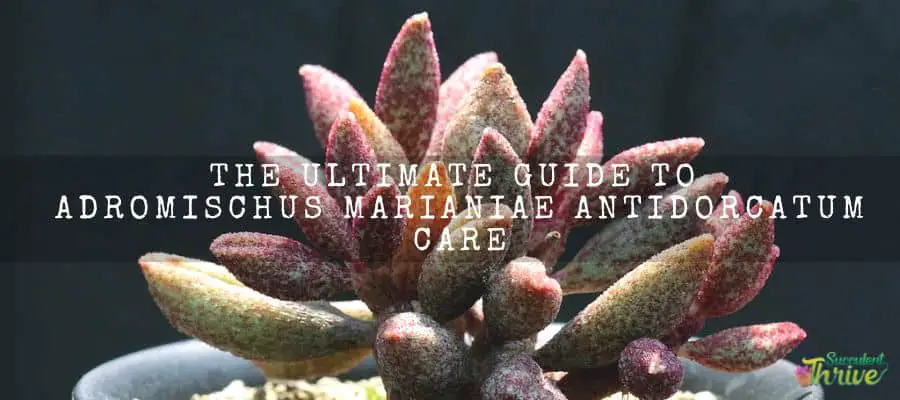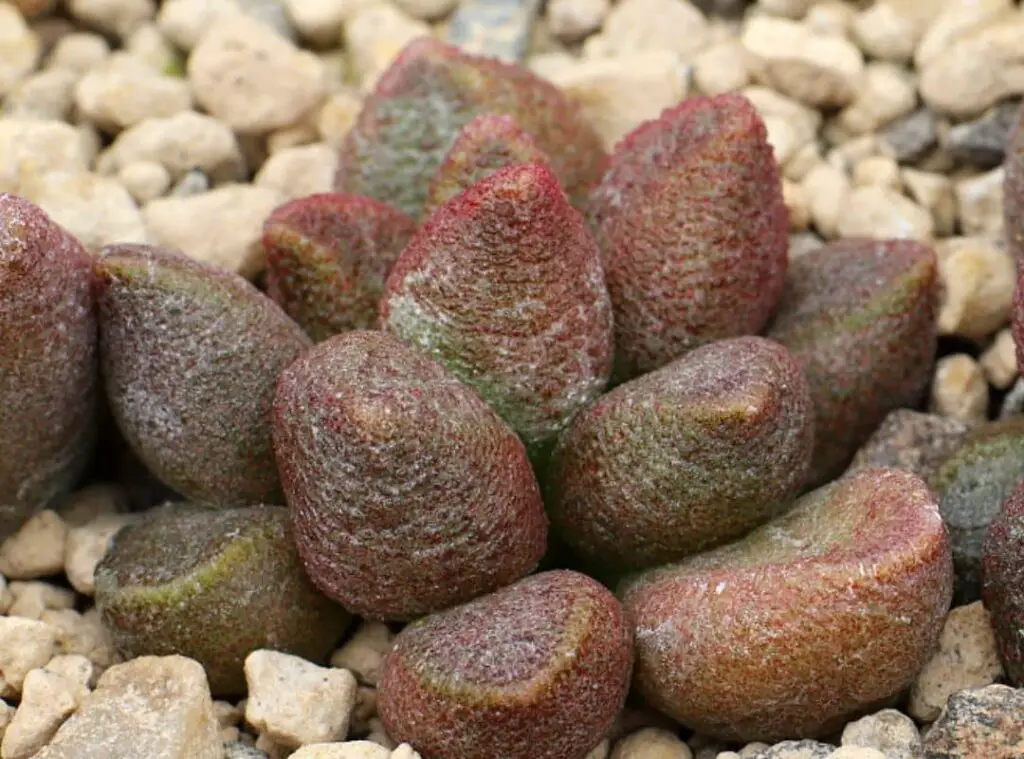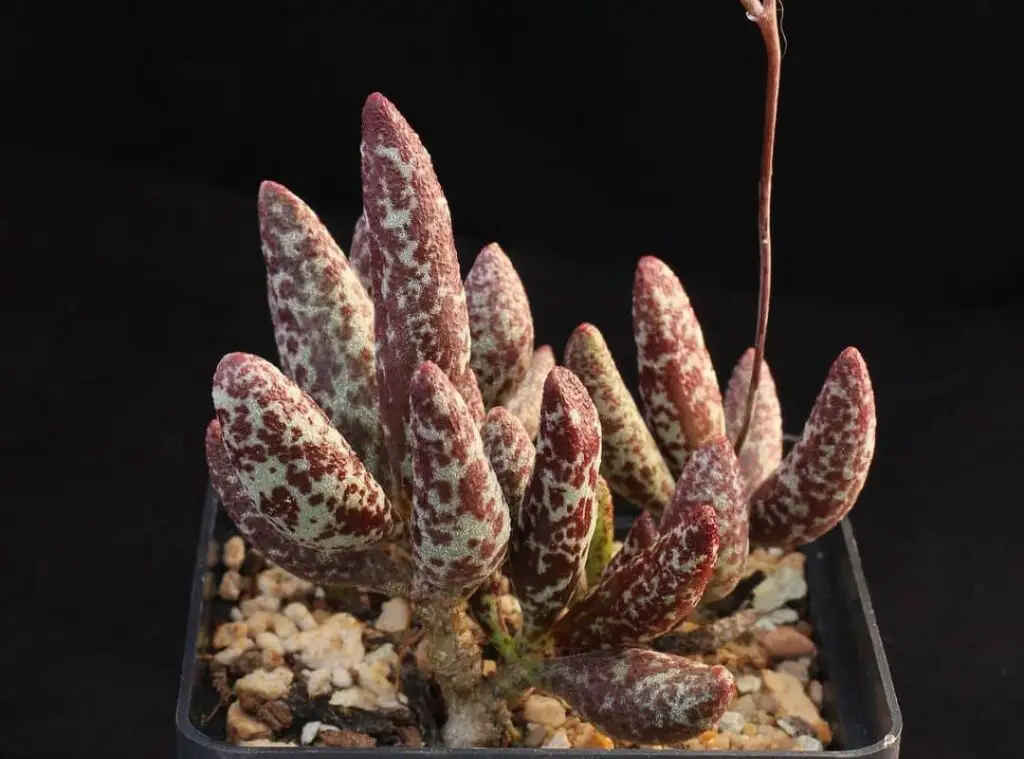Adromischus marianiae antidorcatum are uniquely shaped beautiful succulents. They are eye-catching and anybody would fall in love with these plants.
So, if you already own an Adromischus marianiae antidorcatum Plant and wish to make them good looking, you will find this article very useful.

Having said that, even a novice in cactus gardening can start growing them as they are low maintenance plants. So, this article will give you comprehensive details on how to grow them from scratch.
They belong to the Crassulaceae family. In terms of the origin of these plants, they are endemic plants to Cape provinces. Further they would make the granite hills their natural habitats. So, if you are curious to learn on these beauties, I invite you to go through this article
How do I identify Adromischus marianiae antidorcatum?
Adromischus marianiae antidorcatum usually form as shrubs. They would usually form in an erect manner and develop a cluster of distinctive leaves.
They would attain a maximum height of 10 cm when they reach maturity. Their stem would form erect too. Besides, they would have a short rosette too.
If I describe the Adromischus marianiae antidorcatum leaves, they would be spherical and oblongolate in shape. Moreover they would be tapered at the ends as well.
Adromischus marianiae antidorcatum leaves would be prominent in dark green to purple color. Once you touch it you will feel it’s rough. In addition to that, it may also have a slight groove on to the top part of the leaves.
In addition to these factors, they would also form tuberous roots which would conserve water. Furthermore you could witness Adromischus marianiae antidorcatum bearing flowers in spring.
Those blooms are tubular shaped or cub shaped. They would be prominent in green to pink red. If I further elaborate those flowers, they would comprise five fused petals as well.
One might find it difficult to identify the Adromischus marianiae antidorcatum plants with A. marianae f. herrei aubergine plants.
However the only difference between these plants and the Adromischus marianiae antidorcatum is the leaves. Adromischus marianiae antidorcatum leaves are tiny when you compare these two plants.
Size of the plant
Adromischus marianiae antidorcatum plants would be about 10 cm in height.
Growth rate
Adromischus marianiae antidorcatum are slow growing plants.

One look care guide
| Botanical Name | Adromischus marianiae antidorcatum |
| Plant Type | Succulent |
| Mature Size | 10 cm in height |
| Sun Exposure | Full sunlight to partial shade |
| Soil Type | Well draining |
| Soil pH | Neutral |
| Bloom Time | Spring |
| Flower Color | Pink red |
| Native Area | Cape provinces |
| Average price | USD 35 |
How do you take care of the Adromischus marianiae antidorcatum?
Light Requirement
Morning full sunlight and partial shade in the afternoon would be optimal conditions for the Adromischus marianiae antidorcatum.
It is important that Adromischus marianiae antidorcatum gain adequate sunlight as only then they will become vivid in their colors and maintain their shapes.
Further their leaves would also become very fragile and tend to get dropped at the gentle touch. Furthermore, these plants need to have sufficient sunlight as only then they can conduct the photosynthesis process.
Bear in mind to secure the Adromischus marianiae antidorcatum plants from direct sunlight during the hottest hours of the day in summer.
Temperature and humidity
The plants will not withstand temperatures below 10°C. As such, you need to place them indoors during such unhealthy winter conditions. Low humidity levels would work well with these plants the best
Is it cold hardy?
Adromischus marianiae antidorcatum are not cold hardy plants.
Watering Requirement
Watering the Adromischus marianiae antidorcatum well is a critically important factor. Best is to apply water for these plants once a week when they are in the active growing phase.
However, you should always ascertain whether their soil is dry from previous watering sessions and then commence watering them. You need to cut back on watering in winter as they would be dormant during winter.
Adromischus marianiae antidorcatum are succulents and they would thrive well with minimum watering.
So Always make sure that you don’t supply the Adromischus marianiae antidorcatum with water in abundance. Refrain from over watering as chances are that it would even bring fatal impacts on the plants.
Soil Requirement Type / pH.
Adromischus marianiae antidorcatum plants will perform well if you supply them a well-draining soil mix.
It should ideally comprise of elements such as pumice, clay and loam as they will enhance the draining of the soil mix.
Adromischus marianiae antidorcatum are susceptible for root rot and due to that it is critically important that you provide a fast draining soil mix to minimize the potential of having any root rot in the potting medium.
The draining quality of the soil mix is what determines the healthy growth of the Adromischus marianiae antidorcatum plants.
Ideally the right soil mix for the Adromischus marianiae antidorcatum should be layered with cinder at the bottom, peat in the middle and perlite at the top.
You could make a well-draining soil mix on your own by mixing these three elements at a ratio of 6:3:1. You may consider using rocks instead of perlite. However, perlite would be more effective and more attractive here.

Pot size Potting and Repotting
Pot material wise, I suggest you use either clay pots or terracotta pots since they would be the most appropriate pot materials to plant them.
In addition to that, those pots need to have ample drainage too. When it comes to the repotting aspect of the Adromischus marianiae antidorcatum, I suggest you do it once every other year.
Further you should always go ahead with at least 2 cm wider pots so that the roots can grow freely in the new pots.
Furthermore, there will be new growing conditions provided also for the plants. Consider that you had grown the plants in the same pot for too long, then chances are that the plants may be more prone towards pests’ attacks and for other diseases as well.
However ensure that you conduct repotting in the early stage of the active growing season. Once you conduct the process, make sure that you watch out for any signs of root rot.
Check whether there are any blackened or decaying plants parts. If you come across any of them you could cut them off and treat them with fungicides.
Where to Plant
You need to plant the Adromischus marianiae antidorcatum in a location where they can absorb morning full sunlight and partial shade during the scorching hours of the day.
Furthermore, I suggest you plant them in light containers so that you could move the plants in and out from your home when the unhealthy weather conditions arrive. Lastly, bear in mind to provide a substrate which is fast draining too.
Fertilizer and time of year
I suggest you feed the Adromischus marianiae antidorcatum moderately when they are actively growing. You can obtain fertilizers which are specifically made for the succulents to feed them.
On another note, ensure that you don’t feed the Adromischus marianiae antidorcatum during winter.
If you have Adromischus marianiae antidorcatum in bloom stage, you can proceed with liquid fertilizers. Alternatively you may also go ahead with a compound fertilizer which has a low component of nitrogen and a high component of phosphorus and potassium.
It is noteworthy to mention that you need to feed the plants either in the morning or in the evening when there are sunny weather conditions.
Flowers
Adromischus marianiae antidorcatum would emerge with flowers in spring. Their blooms would tend to take a tubular shape or a club shape. They would develop in pink red. The flowers will carry five petals in total
Dormancy
Adromischus marianiae antidorcatum are winter dormant plants.
Toxicity
The genus Adromischus is toxic so, I urge you to practice caution when dealing with these plants.
Common bugs and illnesses
Adromischus marianiae antidorcatum may encounter infestations from red spider mites and from mealybugs as well.
However if you maintain the plants healthily, it is very unlikely that they will try to infest the plants. Having said that if your plants ever come across such a situation you need to remedy them with pesticides.
In addition to that, chances are that Adromischus marianiae antidorcatum may also come across root rot especially when you expose them to waterlogged conditions for too long.
Special Care tips
Adromischus marianiae antidorcatum are low maintenance plants and there are no special care tips you need to practice. However, make sure that you supply all its basic growing needs so that they will flourish.
Adromischus marianiae antidorcatum benefits
Adromischus marianiae antidorcatum are useful as ornamental plants. In addition to that you could grow them in cute looking containers as well.
How to propagate Adromischus marianiae antidorcatum
You could use their cuttings and seeds to propagate the Adromischus marianiae antidorcatum plants.
Best time to propagate the Adromischus marianiae antidorcatum plants would be the spring season. I urge you to utilize all sterile, clean and sharp tools to obtain the cuttings. Once you obtain them, you let them dry and allow their cut ends to wither.
After a few days their cut edges would be dry and calloused. As the next step, you may place them in a sandy soil mix which comprises soil and pumice as well.
Best is to use a few cuttings so that you will have better results.. When you conduct the cutting propagation method, you need to expose them for an optimal temperature range around 20 degrees Celsius.
Secondly if you want to use the seeds propagation method, you could simply sow them in a sandy loamy soil mix. Ensure that you are exposing them for high humidity levels and a temperature range of 14 degrees Celsius.
Conclusion
To recap, Adromischus marianiae antidorcatum are such an amazing set of plants which would be so pleasing to watch when they are flourishing. So, I hope now you are all set to start cultivating these magnificent plants
Read Next : Sedum Succulent Care ( Special Tips )


